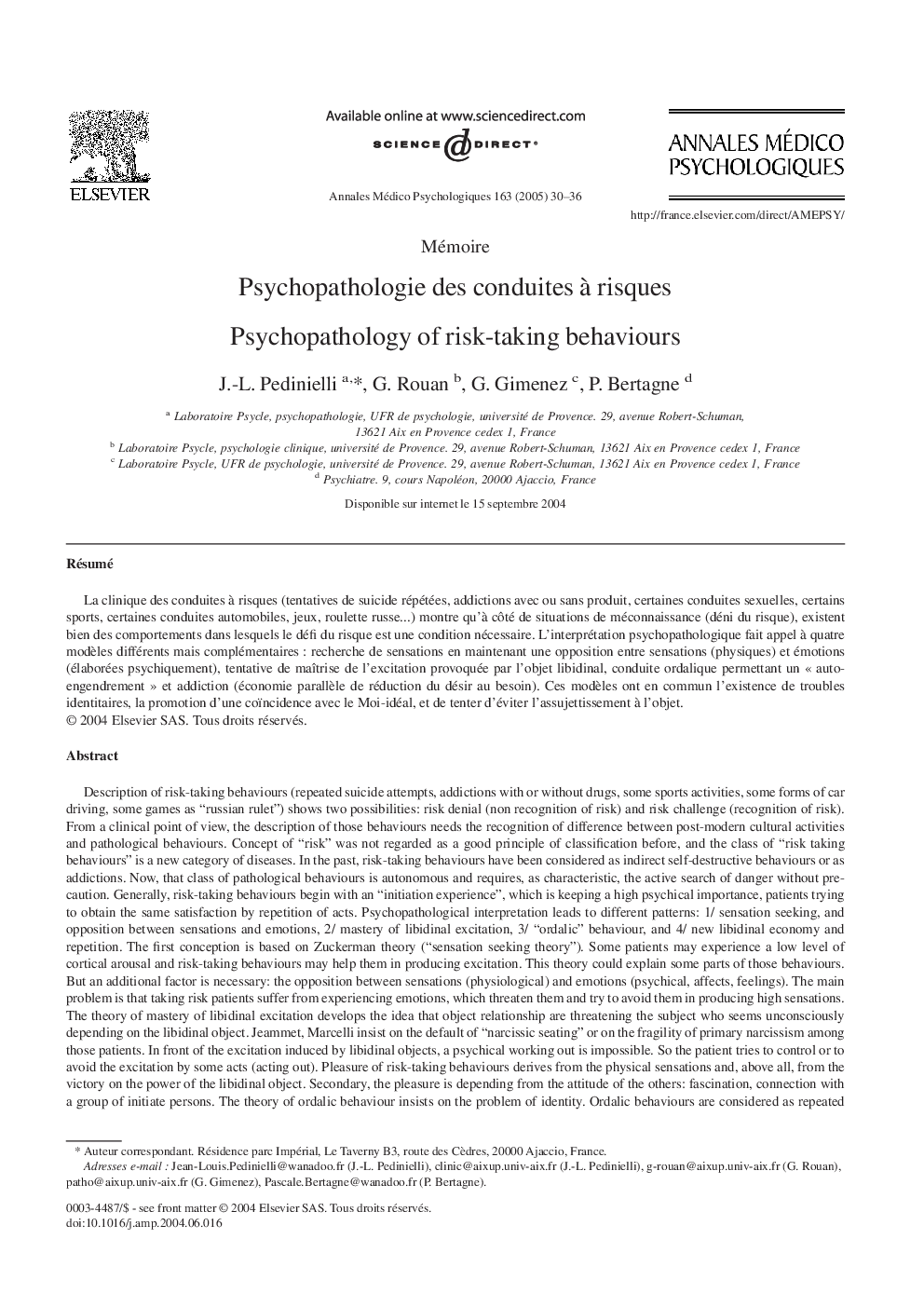| کد مقاله | کد نشریه | سال انتشار | مقاله انگلیسی | نسخه تمام متن |
|---|---|---|---|---|
| 10297338 | 536772 | 2005 | 7 صفحه PDF | دانلود رایگان |
عنوان انگلیسی مقاله ISI
Psychopathologie des conduites à risques
دانلود مقاله + سفارش ترجمه
دانلود مقاله ISI انگلیسی
رایگان برای ایرانیان
کلمات کلیدی
موضوعات مرتبط
علوم پزشکی و سلامت
پزشکی و دندانپزشکی
روانپزشکی و بهداشت روانی
پیش نمایش صفحه اول مقاله

چکیده انگلیسی
Description of risk-taking behaviours (repeated suicide attempts, addictions with or without drugs, some sports activities, some forms of car driving, some games as “russian rulet”) shows two possibilities: risk denial (non recognition of risk) and risk challenge (recognition of risk). From a clinical point of view, the description of those behaviours needs the recognition of difference between post-modern cultural activities and pathological behaviours. Concept of “risk” was not regarded as a good principle of classification before, and the class of “risk taking behaviours” is a new category of diseases. In the past, risk-taking behaviours have been considered as indirect self-destructive behaviours or as addictions. Now, that class of pathological behaviours is autonomous and requires, as characteristic, the active search of danger without precaution. Generally, risk-taking behaviours begin with an “initiation experience”, which is keeping a high psychical importance, patients trying to obtain the same satisfaction by repetition of acts. Psychopathological interpretation leads to different patterns: 1/ sensation seeking, and opposition between sensations and emotions, 2/ mastery of libidinal excitation, 3/ “ordalic” behaviour, and 4/ new libidinal economy and repetition. The first conception is based on Zuckerman theory (“sensation seeking theory”). Some patients may experience a low level of cortical arousal and risk-taking behaviours may help them in producing excitation. This theory could explain some parts of those behaviours. But an additional factor is necessary: the opposition between sensations (physiological) and emotions (psychical, affects, feelings). The main problem is that taking risk patients suffer from experiencing emotions, which threaten them and try to avoid them in producing high sensations. The theory of mastery of libidinal excitation develops the idea that object relationship are threatening the subject who seems unconsciously depending on the libidinal object. Jeammet, Marcelli insist on the default of “narcissic seating” or on the fragility of primary narcissism among those patients. In front of the excitation induced by libidinal objects, a psychical working out is impossible. So the patient tries to control or to avoid the excitation by some acts (acting out). Pleasure of risk-taking behaviours derives from the physical sensations and, above all, from the victory on the power of the libidinal object. Secondary, the pleasure is depending from the attitude of the others: fascination, connection with a group of initiate persons. The theory of ordalic behaviour insists on the problem of identity. Ordalic behaviours are considered as repeated acts of facing to danger; they lead to a feeling of regeneration, of new birth by facing with death. The principal aims of ordalic behaviours are not a self-destruction but the possibility of living. Some patients have such identity and narcissic problems that they have to repeat those ordalic experiences to maintain the “positive” consequences of the behaviour. The ordalic behaviours allow having body limits, to cancel the difference between Ego and Ideal Ego, to produce symbolic identity. Some risk-taking behaviours are repeated and some patients begin dependent on the experience. Some authors regarded these behaviours, in that case, as addictions (repetition and dependence) to risk. The first problem is to understand what “risk” is representing in the subjectivity because of the certainty and uncertainty of the consequences of the action. The second aspect is that the theory of addictions brings an interpretation of risk-taking behaviours. The theory insists on some transformations: need instead of wish, material object instead of libidinal object, and specific action instead of demand⦠Some patients with risk-taking behaviours show a lack of introjections and a strong use of incorporation. The four interpretations are not opposed but complementary. Those interpretations may share the same principle: the behaviour is used to avoid dependence to the libidinal object and leads to another dependence.
ناشر
Database: Elsevier - ScienceDirect (ساینس دایرکت)
Journal: Annales Médico-psychologiques, revue psychiatrique - Volume 163, Issue 1, February 2005, Pages 30-36
Journal: Annales Médico-psychologiques, revue psychiatrique - Volume 163, Issue 1, February 2005, Pages 30-36
نویسندگان
J.-L. Pedinielli, G. Rouan, G. Gimenez, P. Bertagne,